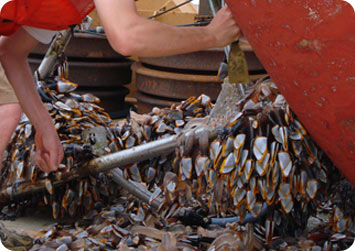After pirates and rising fuel prices, a ship owner’s worst enemy just might be a creature that’s not much bigger than a quarter: the barnacle. When enough of them glom onto a ship’s hull, they slow the ship down and cut its fuel efficiency by up to 25 percent.

That makes the barnacle a big pest -- which is about the only “big” thing about it.
Barnacles are crustaceans, so they’re relatives of shrimp, crabs, and lobsters. When they hatch, they float through the water until they reach a hard surface, such as a rock, a jetty, a boat dock -- or the hull of a ship.
The young barnacle sticks to the surface head-first, and cements itself with a glue that’s similar to the enzyme that causes clotting in human blood. The glue is almost impossible to dissolve, so the only way to get rid of the barnacle is to scrape it off.
Once it’s in place, the young barnacle starts building a “house” around itself -- a shell made of the same mineral that makes up limestone. The barnacle will spend the rest of its life inside the shell.
To feed, the barnacle pokes its legs through an opening in the top of the shell. Feather-like structures on the legs snare tiny organisms and other bits of organic matter from the water.
Many barnacles live in places where they’re sometimes exposed to the air -- on rocks that are exposed when the tide rolls out, for example. When they’re uncovered, they simply close up their shells, where they remain snug and wet until they’re once again covered by the advancing tide.

